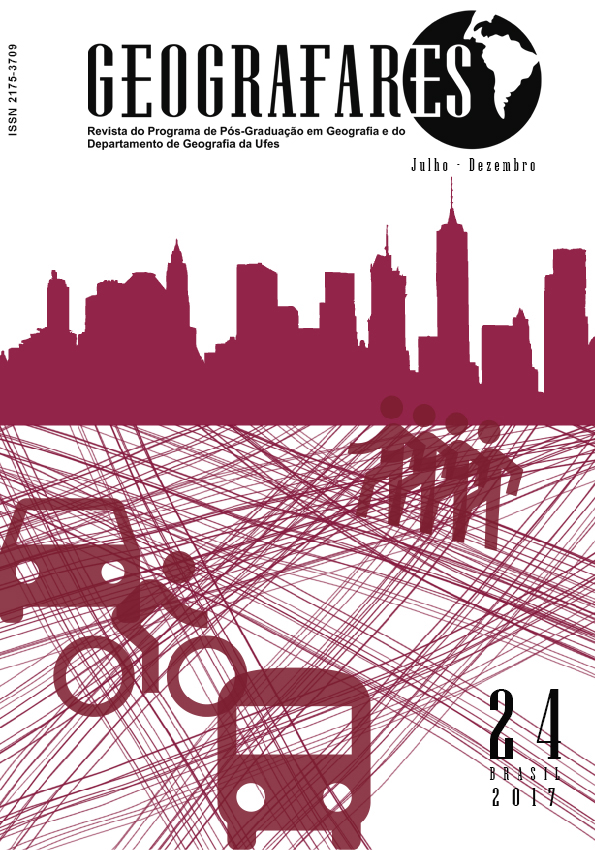MOBILIDADE ESPACIAL NA FRONTEIRA E A FORMAÇÃO DE ESPAÇOS DE VIDA NA AMAZÔNIA: O CASO DAS CIDADES GÊMEAS DE GUAJARÁ-MIRIM (BRASIL) E GUAYARAMERÍN (BOLÍVIA)/Spatial mobility on the border and the formation of spaces of life in Amazon: the case of cities twins of Guajará-Mirim (Brazil) and Guayaramerín (Bolivia)
DOI:
https://doi.org/10.7147/GEO24.17051Resumo
Este artigo tem como objetivo principal analisar a mobilidade espacial na fronteira a partir da dinâmica social das cidades gêmeas de Guajará-Mirim (Brasil) e Guayaramerín (Bolívia). O Censo Demográfico Brasileiro de 2010 demonstra como se configura a migração internacional na Amazônia brasileira e a partir dessas informações que identificamos a importância das cidades gêmeas deste estudo. Assim, constata-se que em termos de migração acumulada, destaca-se a Bolívia com os maiores volumes de estrangeiros na Amazônia brasileira concentrados principalmente em municípios da faixa de fronteira. A configuração espacial destaca a importância de cidades gêmeas como Guajará-Mirim (Brasil) e Guayaramerín (Bolívia) nessa dinâmica. Entretanto, a porosidade da fronteira é configurada pela mobilidade de pessoas e não necessariamente pela migração. Por conta da mobilidade foi utilizado o conceito de “espaço de vida” de Corgeau (1988) como uma proposta teórica metodológica para integrar abordagens macro (escala regional) e micro (escala local) assim como quantitativas e qualitativas para repensar o papel da fronteira na dinâmica demográfica. Conclui-se que a migração internacional e a mobilidade na fronteira são processos complementares que ajudam a entender a dinâmica social das cidades gêmeas. No sentido de que articulam diferentes escalas de fenômenos relacionados a distribuição espacial da população na Amazônia brasileira constituindo espaços de vida com características especificas configurado pela prática de atividades transnacionais daqueles que ali residem e utilizam a fronteira.
ABSTRACT
This article has as main objective to analyze the space mobility in the frontier from the social dynamics of the twin cities of Guajará-Mirim (Brazil) and Guayaramerín (Bolivia). The Brazilian Demographic Census of 2010 demonstrates how international migration is configured in the Brazilian Amazon and from this information we identify the importance of the twin cities of this study. Thus, in terms of accumulated migration, Bolivia stands out with the largest volumes of foreigners in the Brazilian Amazon, concentrated mainly in municipalities along the border. The spatial configuration highlights the importance of twin cities such as Guajará-Mirim (Brazil) and Guayaramerín (Bolivia) in this dynamic. However, the porosity of the border is shaped by the mobility of people and not necessarily by migration. Due to mobility, Courgeau's concept of "living space" (1988) was used as a theoretical methodological proposal to integrate macro (regional scale) and micro (local scale) approaches as well as quantitative and qualitative approaches to rethinking the role of the frontier in Demographic dynamics. It is concluded that international migration and mobility at the border are complementary processes that help to understand the social dynamics of twin cities. In the sense that they articulate different scales of phenomena related to the spatial distribution of the population in the Brazilian Amazon, constituting spaces of life with specific characteristics configured by. the practice of transnational activities of those who reside there and use the frontier.
Keywords: International Mobility, Border, Life Spaces.
Downloads
Downloads
Publicado
Como Citar
Edição
Seção
Licença
Autores que publicam nesta revista concordam com os seguintes termos:- Autores mantém os direitos autorais e concedem à revista o direito de primeira publicação, com o trabalho simultaneamente licenciado sob a Licença Creative Commons Attribution que permite o compartilhamento do trabalho com reconhecimento da autoria e publicação inicial nesta revista.
- Autores têm autorização para assumir contratos adicionais separadamente, para distribuição não-exclusiva da versão do trabalho publicada nesta revista (ex.: publicar em repositório institucional ou como capítulo de livro), com reconhecimento de autoria e publicação inicial nesta revista.
- Autores têm permissão e são estimulados a publicar e distribuir seu trabalho online (ex.: em repositórios institucionais ou na sua página pessoal) (Veja O Efeito do Acesso Livre).












1.png)





